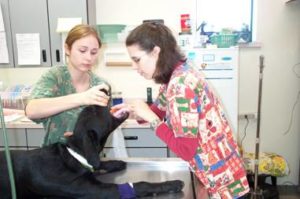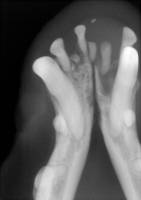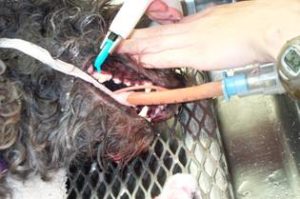Contact Us
Reach out to us and we will be happy to answer any questions, discuss your pet’s health and book an appointment.
Call: 360-354-5095
Text: 360-383-5170
we.care@kulshanvet.com
Most of us are very familiar with what happens when we visit our dentist’s office for a dental cleaning. In contrast, bringing your pet into the hospital and dropping it off to have its teeth cleaned can produce some anxiety simply because of the unknown.
While there are many similarities between what happens to you and what is done to your pet, there are also some significant differences.
Once an appointment is scheduled for your pet’s teeth cleaning, the doctor reviews your pet’s chart and determines if any pre-anesthetic testing is recommended to increase the safety of the procedure. Unlike humans, pets do not willingly open their mouths and allow us to scrape the plaque and tartar from their teeth. Anesthesia is important to ensure that your pet holds still, is not painful and that its airway is protected.
 While anesthesia does represent a risk, Kulshan uses the safest anesthetics and anesthetic protocols available to maximize your pet’s safety. We also utilize the information gathered from lab work and EKG’s to make the best decisions related to which anesthetics to use and how much to give. While your pet is under anesthesia, various monitors similar to those used in human hospitals are used to monitor your pet’s vital signs as well.
While anesthesia does represent a risk, Kulshan uses the safest anesthetics and anesthetic protocols available to maximize your pet’s safety. We also utilize the information gathered from lab work and EKG’s to make the best decisions related to which anesthetics to use and how much to give. While your pet is under anesthesia, various monitors similar to those used in human hospitals are used to monitor your pet’s vital signs as well.
Your pet can check-in for its dental the night before the procedure or the morning it is scheduled. If you chose to bring them in the day the procedure is scheduled, they should not be allowed access to any food after ten o’clock the night before. This ensures that the stomach is empty which decreases the risks associated with anesthesia. There is no need to restrict access to water. Pets arriving the day of their dental should arrive at the clinic between 7:45 and 8:30 am .
When you and your pet arrive to check in for the dental cleaning, one of our licensed veterinary technicians (similar to a registered nurse) will review the anesthetic consent form and doctor’s recommendations for your pet. These technicians are trained to answer your questions and explain the doctor’s recommendations. This usually takes about ten to fifteen minutes. Once you feel comfortable with their explanations, they will ask for your signature and a contact number where we can reach you while your pet is with us.
This contact number is very important. While emergencies are rare, they do happen and having a viable contact number is crucial to providing your pet with the level of care you desire. Most often this contact information is used to keep you up-to-date on the progress of your pet’s dental and to discuss any additional findings during the dental evaluation. This may include advising you about additional procedures, such as radiographs and/or extractions that would be recommended. If we are unable to contact you, we are frequently forced to delay this additional work which denies your pet from receiving the best dental care and can result in additional costs and inconvenience to you associated with anesthetizing your pet again and bringing it back for an additional appointment.
 After checking in for the dental cleaning, your pet is examined by the attending veterinarian. This includes taking the temperature, getting the weight, checking the teeth, the heart and lungs. With the results of any accepted pre-anesthetic testing and the physical exam, an anesthetic protocol is determined.
After checking in for the dental cleaning, your pet is examined by the attending veterinarian. This includes taking the temperature, getting the weight, checking the teeth, the heart and lungs. With the results of any accepted pre-anesthetic testing and the physical exam, an anesthetic protocol is determined.
When our licensed technician is ready to perform your pet’s dental cleaning, it is anesthetized and the process starts. The technician first removes any large chucks of tartar (the whitish, yellowish, orangish, brownish material that accumulates on the teeth). The teeth are then evaluated for infection, pockets or other evidence of disease. Cavities are not commonly seen in dogs and cats. Any abnormal findings are indicated to the attending doctor and a decision on the best treatment is determined. In the case of pockets and infected teeth, digital radiographs (x-rays) can be taken to determine whether or not a tooth should be removed.
Once any problems have been addressed, plaque is removed from the teeth both above and below using an ultrasonic scaler. Removing the plaque under the gum line is an important step in preventing ongoing disease. All plaque is composed primarily of bacteria. If left undisturbed under the gum line, it puts the teeth at serious risk for infection.
Because of the close association of the blood supply and tooth roots within the bone, this infection can easily enter the blood stream and spread the infection to vital organs such as the heart, kidneys and/or liver.
 Following the removal of all plaque and tartar, your pet’s teeth will be polished and treated with fluoride. Polishing is also an important step in that smoothing the tooth’s surface helps to slow and reduce future plaque/tartar build-up. This is part of why we don’t recommend simply scraping tartar off the teeth as it can damage the enamel and leave scratches that promote the accumulation of plaque/tartar.
Following the removal of all plaque and tartar, your pet’s teeth will be polished and treated with fluoride. Polishing is also an important step in that smoothing the tooth’s surface helps to slow and reduce future plaque/tartar build-up. This is part of why we don’t recommend simply scraping tartar off the teeth as it can damage the enamel and leave scratches that promote the accumulation of plaque/tartar.
Oravet is applied following the polishing of the teeth. This “sealant” bonds electrostatically with the teeth and helps reduce plaque and tartar accumulation. The oravet applied while your pet is under anesthesia is much more concentrated than the home applied product. Not only does it help reduce dental disease, but it also serves as a foundation for application of the home product. (For more information on Oravet, visithttp://www.oravet.us.merial.com)
The final step of the dental cleaning is documenting the condition of your pet’s mouth. The technician will record which teeth are missing or were extracted, information on oral disease and general oral health. These notes are an important part of your pet’s medical record and allow us to follow the progress of its health. We also put this information into the client information sheet to communicate the state of your pet’s dental care to you and for you to file in your copy of your pet’s medical record.
After the dental, your pet is monitored closely while it wakes up from anesthesia. This includes keeping it warm and comfortable and getting it ready to go home.
 Most pets go home the same day as their dental cleanings. It is important to remember that they may still be a little sleepy from the anesthetic and events of the day. Some also may be a little sore from having plaque/tartar removed or from having teeth removed. Depending on the condition of the oral health and what was done, antibiotics and/or pain medications may be sent home to complete their treatment. In these cases, directions will be on the bottle labels and within the go-home instructions.
Most pets go home the same day as their dental cleanings. It is important to remember that they may still be a little sleepy from the anesthetic and events of the day. Some also may be a little sore from having plaque/tartar removed or from having teeth removed. Depending on the condition of the oral health and what was done, antibiotics and/or pain medications may be sent home to complete their treatment. In these cases, directions will be on the bottle labels and within the go-home instructions.
If your pet seems to be slower for more than 24 hours following the dentistry, please give us a call as this may be the indication of complications associated with the procedure.